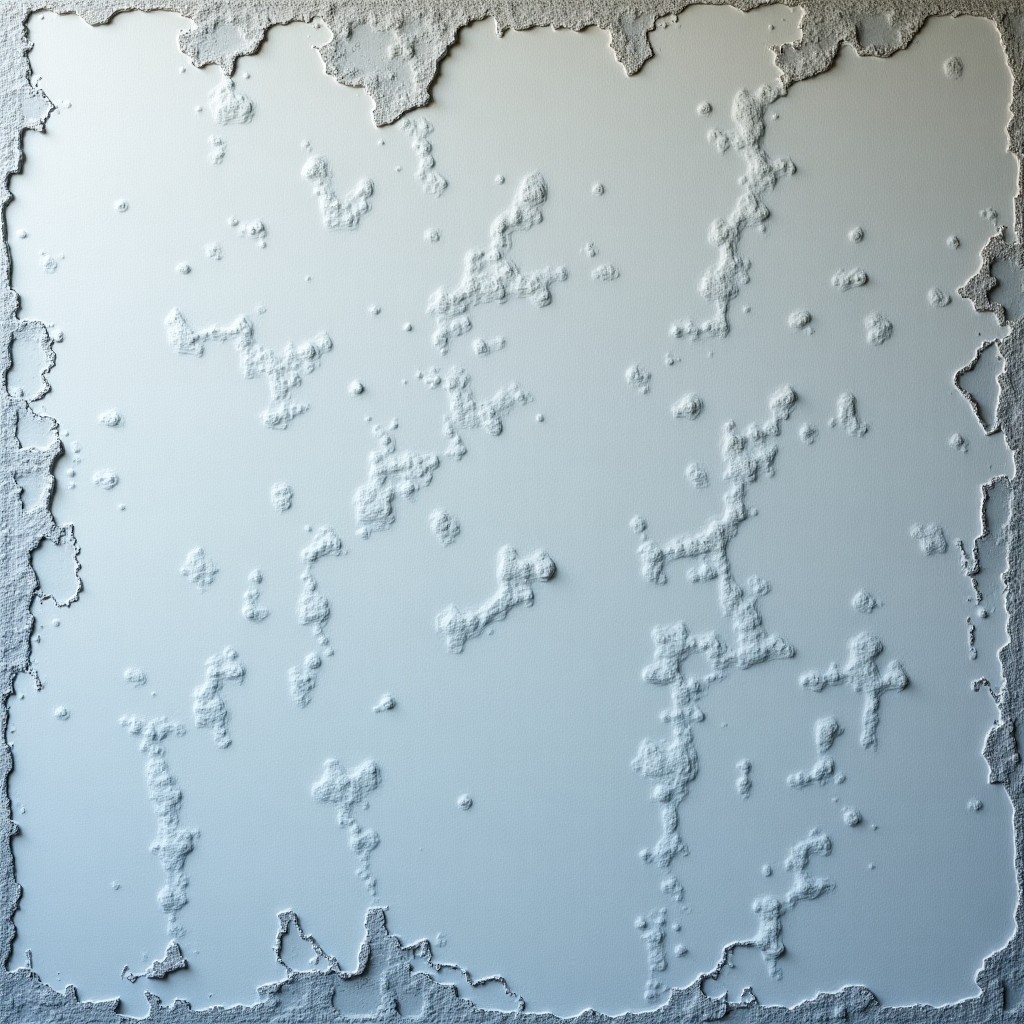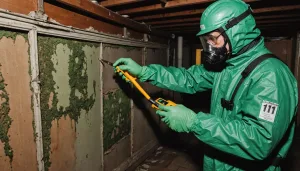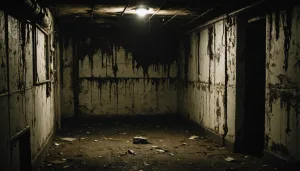Hidden water leaks can pose significant risks to your property, often leading to expensive repairs if not detected in time. To safeguard your home, it’s crucial to recognize the common signs of hidden water leaks. By understanding what to look for, you can engage in preventative maintenance and potentially avoid major damage.
One of the earliest indicators of a hidden water leak is an unexpected increase in your water bill. If your water usage habits haven’t changed but your bill has surged, it might be time to consider plumbing issues or leaks as potential culprits. It’s advisable to track your consumption patterns to quickly identify anomalies.
Another sign to watch for is the formation of mold or mildew. Water leaks can create damp environments, which are perfect breeding grounds for these fungi. Mold and mildew often emit a musty odor, and their presence could indicate water seepage behind walls or under flooring. Pay close attention to areas where water pipes run, especially if the walls or ceilings exhibit unexplained discoloration.
Additionally, bubbling or peeling paint and wallpaper can signify moisture trapped beneath the surface. This is particularly common in areas exposed to consistent moisture or where plumbing is involved. While aesthetic changes might go unnoticed at first, an inspection may reveal deeper issues requiring professional leak detection services.
Unusual sounds, such as dripping or running water when all faucets are shut off, are also red flags. This could be symptomatic of leaks within walls or under floors, requiring immediate investigation to prevent further structural damage.
Here is a comparative table to quickly review common signs of hidden water leaks:
| Sign | Description |
| Increase in Water Bill | Sudden rise in water costs without a change in usage |
| Mold/Mildew Growth | Presence of a musty smell and visible mold patches |
| Bubbling Paint/Wallpaper | Paint or wallpaper distorting due to underlying moisture |
| Unexplained Sounds | Dripping or running water sounds with no apparent source |
By familiarizing yourself with these common signs, you can be proactive in detecting potential leaks. Prompt action can not only mitigate damage but also save on repair costs, making preventative maintenance an essential aspect of homeownership. Always keep plumbing tools and resources at hand, and don’t hesitate to seek professional advice if these indicators appear in your home.
checking high-risk areas
Proactively identifying potential leak-prone areas in your home can significantly limit the damage they cause over time. Focus your attention on high-risk areas where plumbing systems are most concentrated or exposed to stress, as these spots are often the origin of hidden water leaks. Follow this systematic approach to thoroughly check these critical zones:
- Inspect Kitchens and Bathrooms:
– Check under sinks for dampness or drips around plumbing connections. Use a flashlight to examine pipes for corrosion or moisture buildup.
– Look behind appliances such as dishwashers and washing machines. Pull them out to inspect hoses for any signs of wear or leaks.
– Examine showerheads and faucets; if anything is leaking, you’ll often find mineral deposits or moisture around these fixtures. - Examine Around Water Heaters:
– Look for pooling water or dampness around the base of the water heater.
– Check for rust or corrosion on the tank and its connections, a telltale sign that leaks may develop.
– If applicable, inspect the relief valves and their drainage tubes for leaks. - Review Basements and Crawl Spaces:
– Check the floors and walls for any signs of moisture or water marks. Leaks in these areas might not be immediately obvious.
– Inspect where the foundation meets the walls for any signs of dampness. These might be caused by seepage or plumbing leaks. - Assess Attics and Roofs:
– Look for water stains on the ceiling, a clear indication that water might be seeping through from the roof.
– Check the seals around attic vents and chimneys to ensure they’re airtight and free of leaks. - Focus on Outdoor Plumbing:
– Inspect hoses and outdoor faucets. Leaky outdoor fixtures can lead to costly water wastage and contribute to higher water bills.
– In periods of cold weather, make sure all outdoor faucet covers are securely in place to prevent freezing and potential pipe bursts.
These inspections should be integrated into routine preventative maintenance schedules, carried out at least bi-annually. Not only will this help in early detection of potential issues, but it will also ensure substantial savings by mitigating extensive damages typically associated with hidden water leaks.
using your water meter as a leak detector
Your water meter can be an incredibly effective tool in the quest for leak detection, acting as a pivotal player in identifying hidden water leaks in your home. Here’s how you can leverage your water meter to pinpoint leaks and embrace preventative maintenance:
Begin by ensuring that no water is being used in your household — this means shutting off all faucets, ensuring that no appliances like dishwashers or washing machines are running, and confirming that irrigation systems are inactive. With all water usage halted, proceed to locate your water meter, typically installed either in your basement or outside near your property line.
Once you locate your meter, observe the low-flow indicator; its manifestation varies, often taking the form of a small, red, or white wheel or triangle. This indicator is highly sensitive and will move in the presence of even the smallest water usage. If it continues to spin with all water turned off, this is a strong indication of a leak somewhere in your plumbing system.
In addition, most meters are equipped with a totalizer, displaying the cumulative usage. To further verify the presence of a leak, jot down the reading on the meter and refrain from using water for a couple of hours. Recheck the meter after this period. A changed reading without usage suggests a leak.
Employing your water meter in this way offers various benefits, most notably early identification of leaks, which reduces the potential for severe property damage. It allows you to adopt proactive strategies towards maintenance, mitigating the risk of ending up with colossal repair costs later on. By regularly checking your water meter and staying vigilant, you can effectively manage your water consumption and uphold the health of your plumbing systems.
Engaging in such preventative maintenance minimizes the necessity for emergency plumbing repairs, aiding in more efficient water usage and saving on utility bills in the long run. The prominent advantage here is the empowerment to oversee your water usage actively and pinpoint issues before they escalate. This empowers homeowners to maintain the plumbing infrastructure effectively, ensuring that homes remain secure and free from the perils hidden leaks can pose.
the importance of regular maintenance
Regular maintenance is an essential part of safeguarding your home against hidden water leaks and ensuring the longevity of your plumbing system. Consistently applying preventative maintenance practices can significantly reduce the risk of unexpected leaks and the costly damage they bring. The significance of regularly evaluating your plumbing infrastructure cannot be overstated, as small issues, if left unattended, can spiral into major problems.
Firstly, routine inspections of your plumbing system help detect early signs of wear and tear. Pipes, especially older ones, can corrode, and joints can loosen over time, leading to potential leaks. By frequently examining pipes in accessible areas, homeowners can spot signs of rust, corrosion, or condensation that indicate issues requiring immediate attention. When performing such checks, be attentive to any signs of moisture or mold growth, as these are strong indicators of hidden leaks.
Furthermore, regular maintenance extends to ensuring that your plumbing appliances, such as water heaters, are operating efficiently. Water heaters, if not properly maintained, can develop rust and sediment buildup, which might cause leaks or reduce their efficiency. Regularly draining and servicing your water heater can prevent these issues, improving its lifespan and functionality while avoiding leaks.
Sealing gaps in water infrastructure is another vital component of preventative maintenance. Over time, seals around fixtures and joints may degrade, leading to minor leaks and water damage. Regularly checking these seals and replacing them as needed helps to ensure that your plumbing system remains airtight and free from leaks. This simple step within your maintenance regimen is a powerful line of defense against undetected water flow that might culminate in significant structural damage to your home.
Regularly maintaining your property also involves being aware of your water pressure. High water pressure can strain plumbing systems, making them more susceptible to developing leaks. Installing a pressure regulator and periodically checking the pressure levels can help maintain the optimal operating conditions for your pipes. By staying attuned to these details, homeowners can effectively prevent stress and damage to their plumbing systems.
Finally, don’t underestimate the power of professional leak detection services as part of your maintenance routine. Periodic professional inspections can reveal hidden issues that are not easily visible to the untrained eye. Professional plumbers possess the knowledge and specialized equipment necessary to detect leaks in complex areas, providing peace of mind and preventing surprise repairs in the future.
Incorporating these practices into your home’s upkeep routine not only preserves your plumbing but also enhances your property’s value by mitigating the risk of untimely and costly water damage. Regular maintenance empowers you to take proactive steps, ensuring that safety, efficiency, and peace of mind remain constant companions in your home.
when to call a professional
If you’re observant about changes in your home but are still unsure whether you’re dealing with a hidden water leak, it’s wise to consider involving a professional. Many plumbing issues require specialized tools and expertise that go beyond the scope of regular home maintenance. When faced with persistent signs of a leak, such as a continually increasing water bill, ongoing musty odors, or visible mold growth that won’t diminish, these are strong indicators that professional intervention might be needed.
Another scenario where calling in a professional is prudent is when you suspect leaks in inaccessible or hard-to-reach sections of your home. These could include leaks within walls, underflooring, or in places where pipes are deeply embedded. In such cases, trying to fix or even identify the source of the leak on your own could result in further damage. Professionals utilize advanced leak detection equipment such as infrared cameras, moisture meters, and acoustic sensors to precisely locate the leak without causing extensive damage to your property.
If you find that DIY fixes and regular preventative maintenance isn’t addressing the issue, or if you’re dealing with significant water damage, engaging an expert becomes even more important. Professionals not only address existing leaks but can also provide valuable insight into potential vulnerabilities in your plumbing system, offering solutions that enhance durability and efficiency.
Calling a professional is particularly wise when dealing with potential sewer line issues or significant water pressure fluctuations, as these areas require specific skills and equipment. Moreover, if you’re planning any renovations that involve moving existing plumbing features, professional guidance can ensure that the new setup doesn’t inadvertently create opportunities for leaks.
Handling water leaks with professional assistance not only resolves the immediate problem efficiently but also helps prevent recurrence, safeguarding your home from future water damage. This proactive approach not only minimizes potential anxiety over hidden leaks but also supports the longevity and reliability of your home’s entire plumbing system.
In conclusion, managing hidden water leaks can be a daunting task, but it doesn’t have to lead to major damage if addressed promptly and effectively. Recognizing the common signals, rigorously inspecting high-risk areas, and leveraging your water meter for early detection are vital steps. Consistently maintaining your plumbing system plays a crucial role in preempting leaks. Nevertheless, knowing when to reach out for professional help is an integral part of safeguarding your home. Ensuring that these strategies are in the forefront of your maintenance routine protects your property, ensuring it remains a safe and secure haven against the perils of hidden water leaks.





